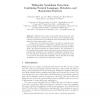WWW
2011
ACM
13 years 7 months ago
2011
ACM
Online social networks have become very popular in recent years and their number of users is already measured in many hundreds of millions. For various commercial and sociological...
WWW
2011
ACM
13 years 7 months ago
2011
ACM
Modern search engines are expected to make documents searchable shortly after they appear on the ever changing Web. To satisfy this requirement, the Web is frequently crawled. Due...
WWW
2011
ACM
13 years 7 months ago
2011
ACM
Facial attributes such as gender, race, age, hair style, etc., carry rich information for locating designated persons and profiling the communities from image/video collections (...
WWW
2011
ACM
13 years 7 months ago
2011
ACM
In this paper, we use the structural and relational information on the Web to find entity-pages. Specifically, given a Web site and an entity-page (e.g., department and faculty ...
WWW
2011
ACM
13 years 7 months ago
2011
ACM
Mashups on traditional desktop devices are a well-known source of security risks. In this paper, we examine how these risks translate to mobile mashups and identify new risks caus...
WWW
2011
ACM
13 years 7 months ago
2011
ACM
This paper gives an overview of a politeness recognition tool (PoRT) for Hindi that is currently under preparation. It describes the the kind of problems that need to be tackled w...
WWW
2011
ACM
13 years 7 months ago
2011
ACM
Online social media are complementing and in some cases replacing person-to-person social interaction and redefining the diffusion of information. In particular, microblogs have ...
WWW
2011
ACM
13 years 7 months ago
2011
ACM
Wikipedia is an online encyclopedia which anyone can edit. While most edits are constructive, about 7% are acts of vandalism. Such behavior is characterized by modifications made ...
WWW
2011
ACM
13 years 7 months ago
2011
ACM
Once information retrieval has located a document, and information extraction has provided its contents, how do we know whether we should actually believe it? Fact-finders are a ...
WWW
2011
ACM
13 years 7 months ago
2011
ACM
We propose a new paradigm for displaying comments: showing comments alongside parts of the article they correspond to. We evaluate the effectiveness of various approaches for thi...




